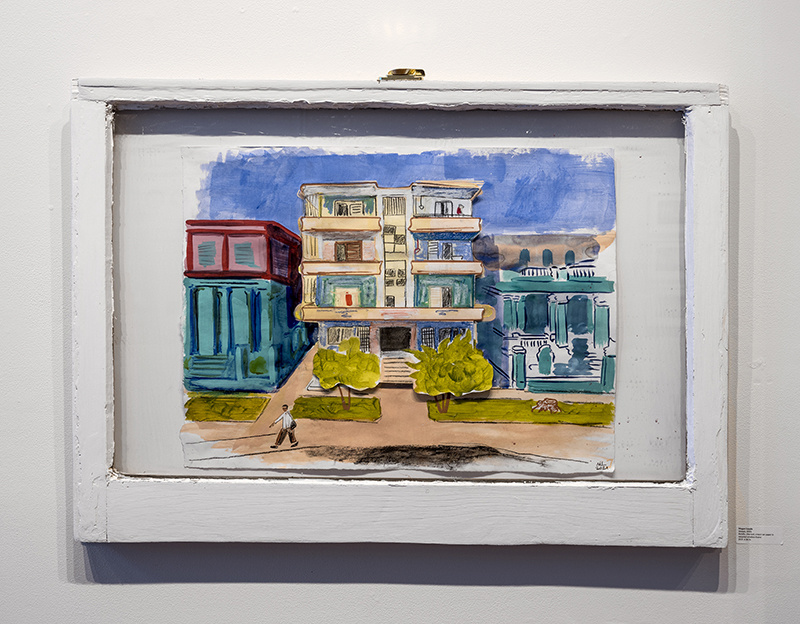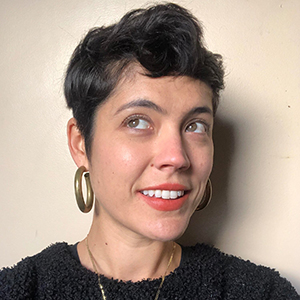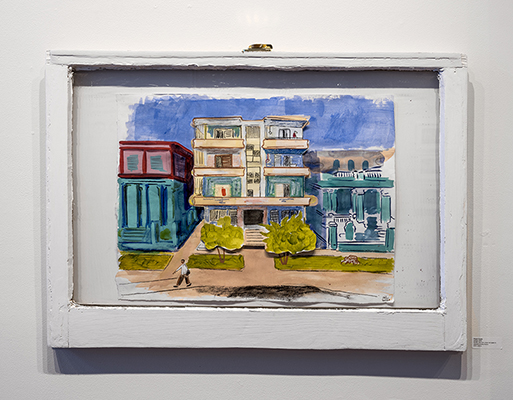
Megan Alma Leppla is a queer Latinx artist and educator whose work seeks to build community through the exploration of intersectional identities. Leppla received a Masters of Arts in Art Education from the Maryland Institute College of Art. She has shown work nationally and internationally through solo exhibitions, group shows, and artist residencies.
Leppla is currently one of Root Division’s Latinx Teaching Artist Fellows. This fellowship provides free studio workspace to two Latinx artists in exchange for being an integral part of Root Division’s Studios Program. In large part, the commitment involves teaching students at Mission Education Center (MEC), a K-5 newcomer school for children who have recently emigrated from Latin America to San Francisco. Working as a teaching-artist in residence for the full school year, Leppla develops and facilitates projects in Root Division’s My Two Homes curriculum, which guides students in discussions, story-telling, and art-making around in their transition to a new home in the U.S.
Leppla’s work is currently on view in the main gallery alongside their students as a part of New Growth 2021: Courage in Creativity, the annual Youth Art Exhibition featuring student artwork created in Root Division’s free after-school Youth Education Program.
Read more below to see Education Fellow Rebecca Sexton’s interview with Megan Leppla about their experience as a Latinx Teaching Artist Fellow, as well as their own artistic practice.

Rebecca Sexton(Education Fellow): How did you begin making art? Was art a large part of your life since childhood?
Megan Leppla: It wasn’t until college that I was exposed to art in a way that felt real. I don’t remember having art classes as a kid. I did have an imagination that transformed ordinary objects into art supplies, mostly props for plays that I put on for my mom. She’s reluctant to accept the title, but my mom was totally an artist to me growing up. She made me clothes and costumes, she even decorated my room by drawing on the walls.
RS: How would you describe your work and practice? What choices do you make, and why are they important to you?
ML: Photography was my first love. It started as a fine arts foundational requirement in community college, but it truly changed my life. The camera became a tool for storytelling. My mom lent me her old Canon AE-1 35MM camera. The process of watching images come to life on paper in the darkroom was pure magic. I graduated with a Bachelor’s in studio art, focusing on photography. I was in the last cohort to have access to that wet darkroom, and I watched as the school transitioned to digital. Digital photography just didn’t feel accessible, I couldn’t keep up with the technology. I found myself in a rural town in South Carolina immediately after graduating. It was there that I had an art residency with a wonderful watercolorist. During those few months I experimented with new ways of storytelling through drawing and painting. It felt like new possibilities opened up, I could allow my relationship to the medium and the materials to be seen.
RS: Your artistic practice explores, as you say in your artist statement, the co-construction of identity through drawing, painting, and installation. Your teaching practice is centered in community. Can you talk about how you see these two practices working together? Do you ever feel that they are at odds?
ML: That’s a great question, one that I think I’m sitting with all the time. The first time that I felt like I had a teacher that really cared about me was in that first photography course in college. Photography felt like it gave me a voice as a learner and as an individual that I hadn’t had before, and I think it had something to do with seeing my teachers share something they were so passionate about. I started teaching art because I wanted to give that same experience to others. When I first started teaching, I was so passionate about getting to do that work and really wanting to create a space that was in collaboration with my students. This is still at the very core of how I approach teaching.
I think the only ways that it feels sometimes in conflict is I think there’s a lot of baggage in the art world around being an educator. There’s this belief that if you’re an educator, you’re not dedicating enough of yourself to your own personal art practice. I just don’t believe that, and I don’t agree with that at all. I think it shifts and changes all the time. There are lots of different variables. I think so much of my teaching informs my art practice and so much of my art practice informs my teaching that. For me, I don’t think I could truly do one without the other.
RS: Can you describe the work that you have done this past year as Root Division’s Latinx Teaching Artist Fellow?
ML: I think, working with Mission Education Center in the Latinx Teaching Artist Fellowship, I am working with a much younger group than I typically do. There’s so much joy and liberation, like play. It’s very different. The students just want to draw, and they just want to make. It feels like an important reminder to me. I’ve committed to always making art alongside my students. Normally, it’s so easy as a teacher to use students’ art-making time to prep; I think we’re always trying to multitask.
When I’m with this group of kids, I want to be fully present for them, to support them in making art, and to make art with them. I commit to doing that with them. I noticed how that shows up in my own personal work too, because there is a more playful quality to the work I’ve been making lately. There’s more embracing of mistakes or not even mistakes, but just learning new ways of doing things. I’m learning to let go of a lot. This piece of being intentional about creating a space that does feel co-authored; it’s not just me coming in and presenting the knowledge or doing a particular art activity. It’s taking space to hear where the students are with their curiosity, their desires, and their motivations.
RS: Can you say more about what you mean by co-authoring?
ML: I think that language was something that I was really thinking a lot about when I was in graduate school. I did this series of work where I would ask people to draw me, and I would draw them. It made me very uncomfortable a lot of the time, but as soon as I would get past that level of discomfort, I realized how much I needed it and how much it felt like healing. I was in grad school in Baltimore. I’m not from Baltimore and didn’t really have a community there. However, there’s a really rich and complex community that exists there and, as a white passing Latinx person, I am a chameleon all the time. I feel myself code-switching for lots of different reasons—sometimes out of safety and sometimes out of privilege.
For me, this notion of co-authoring is how I acknowledge the way I identify and the way you’re going to perceive me. Those two pieces are part of the complex amalgam that is identity. I’m going to move through the world in this type of way, but that doesn’t even matter if all you see is fill-in-the-blank. Now, add gender and on top of that add sexuality. Our identities are so complex. I think I’m really curious about what it would mean to really make space for that co-authoring—what it would mean to make space to allow each individual to express their fullest and most complex selves; and for others to hear that, receive that, and to reflect back. I love the messiness of all of it.
RS: I’m really interested in the things you’re saying. Understanding the deep importance and this idea of co-authoring, I’m wondering how those layers of identity have shown up in the work that you’ve done as one of the Latinx Teaching Artists Fellows this year. I am thinking about this idea of home, which seems central to the curriculum. How are you navigating this work with the students?

ML: I think what I’m interested in is giving them space for duality—giving the students space. For someone who’s an immigrant, for someone who is multiracial, for someone who is not in a binary in any way, it becomes a question of how do we give them the space to celebrate all of it and hold all of it. I think what’s really exciting about working with this age group is that we can talk about it in these ways that don’t have to be so heady.
One day, the students kept talking about food. Everybody loves food, and so we ended up doing this drawing activity where we made a plate. And then, we put our favorite foods on the plate. Everybody was into it, drawing these little things and then, noticing each other’s foods, and adding more and more to their plate. I think creating that space for the duality, creating that space to honor what they hold and to give them permission to celebrate all and both, if that makes sense.
RS: How has the fellowship affected you? How has it influenced your practice?
ML: I think, certainly with the piece that I just shared in the Taste exhibition I was initially set on making this painting on canvas. I kept trying to work through frustrations on the canvas, even working on two seperate canvases at once. Eventually I went back to what I love—playing with materials on paper. I’ve been doing a lot of works on paper, and I think sometimes I get caught up around drawings not being finished pieces, which is my own internal stuff. I wanted to work on canvas because that felt more refined. I got so stuck in this one way. I realized that I wasn’t giving myself space to play..Ultimately, what was happening on paper was so much more alive for me. I realized this is what I wanted to be doing. I think that’s one way the students have affected me, for sure.
I think it’s also been an invitation to just dig more deeply into my own identity, into my own relationship to my Latinx identity, and what that means for me as a Cuban American here in Northern California. I think sometimes it does feel like I have these two homes: my blood family in Florida and my chosen family here. I’m trying to establish my roots here in this new place.
RS: Can you talk a little bit about the piece of work you’ve chosen to display alongside your students’ work? How do you see your piece speaking with and to the work of your students?
ML: I am thinking a lot about it, but I’m prioritizing the kids’ work. Part of me doesn’t want to give much more brain space to my work until I feel like their work is supported and installed.
My piece in the show is in response to one of the projects that we did together that felt really fun in the ways that it kept growing. The kids really wanted to draw trees, and then they wanted to draw treehouses. It just kept organically growing with the kids feeding off each other’s ideas. I loved seeing their imaginations go. Many of the students had never seen a treehouse in person or been inside one, but they had seen them in movies. There was this barrier between actually playing with it, building it, and just drawing whatever they wanted. Some of their tree houses have swimming pools, and slides that go down into underground spaces. It was really wild stuff! For a minute, I wanted to do a treehouse installation. I wanted to build this really wacky thing from our collective imaginations.
This then got me thinking about fantastical and imagined senses of home—how memories can be shifted over time. I was talking to my mom about my grandfather’s backyard and certain things that were there. She didn’t remember or imagine the same things I was imagining. We hold things differently than they were and then other people hold them.
I’ve been working on this painting that I started before the pandemic. I went back to my family’s hometown of Matanzas, Cuba in December 2019. I’ve heard so many different stories about our family there, my abuelo’s reasons for leaving, and getting to see the place for myself felt surreal. It was like being in a familiar place I’d never known, seeing familiar faces of strangers. I started working on this sort of abstract landscape of our home, our former place. There’s this unfinished painting, that in cleaning out my studio recently, I would love to come back to, and it’s been over a year. Right now, it’s really this rough under painting or drawing. With this context of imagined memories and fantastical home, what would that mean and what would that look like—I am thinking about adding some of those layers to it.
